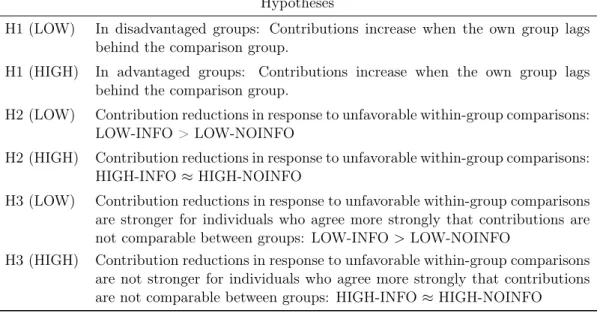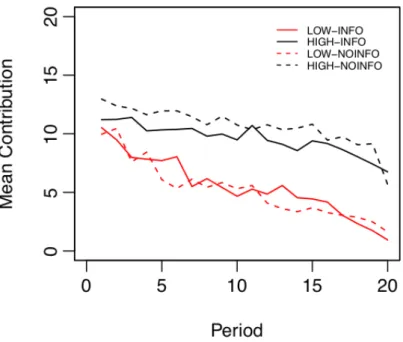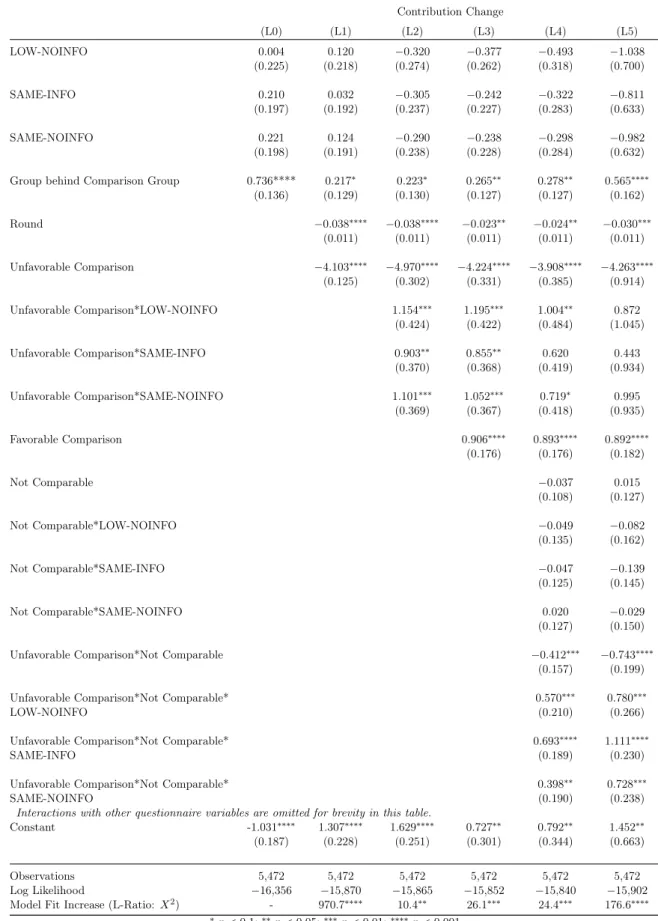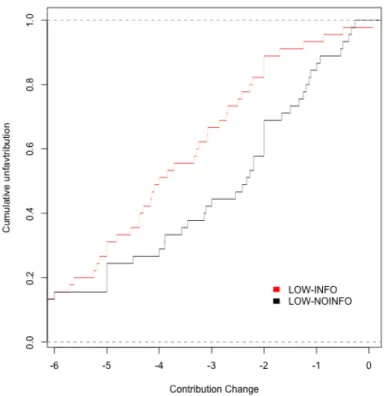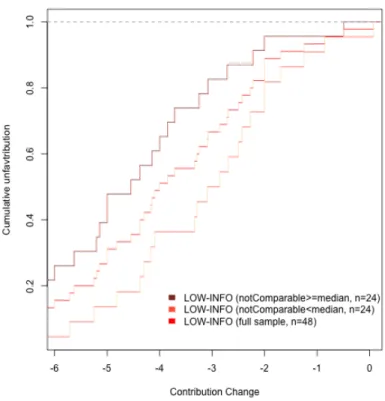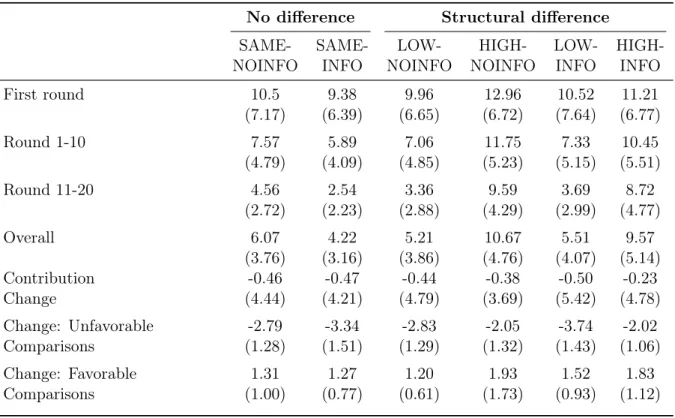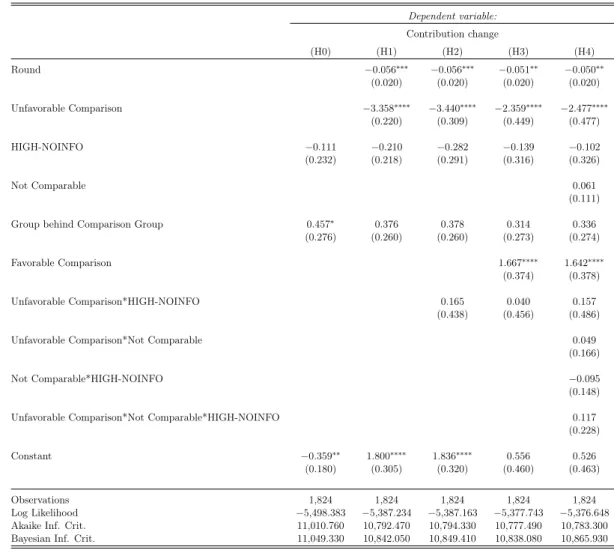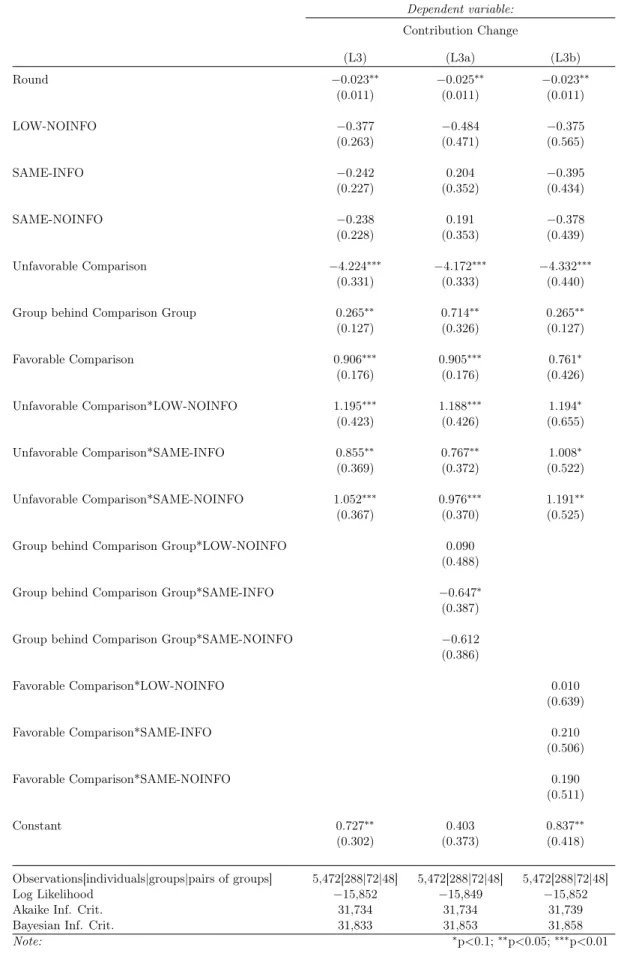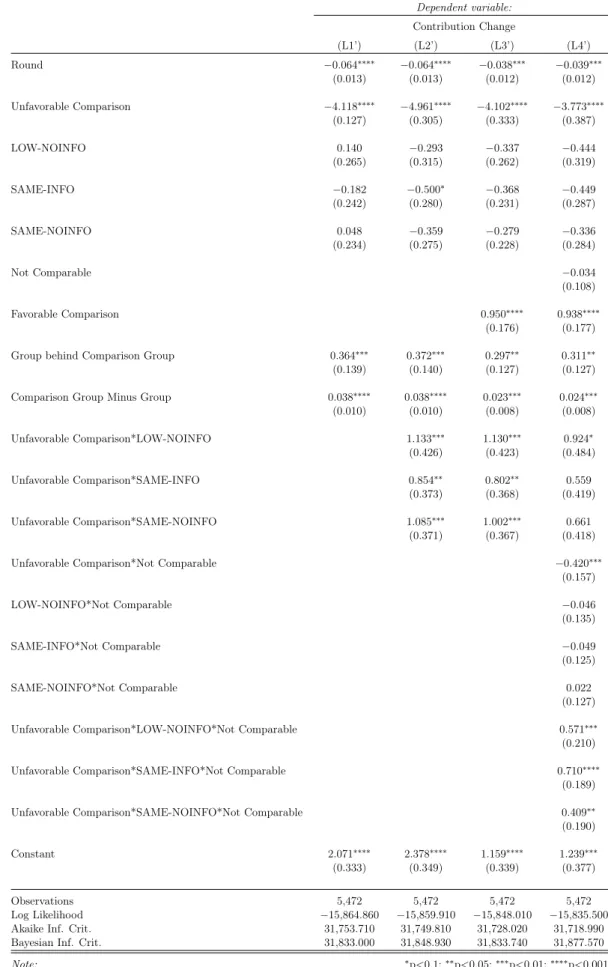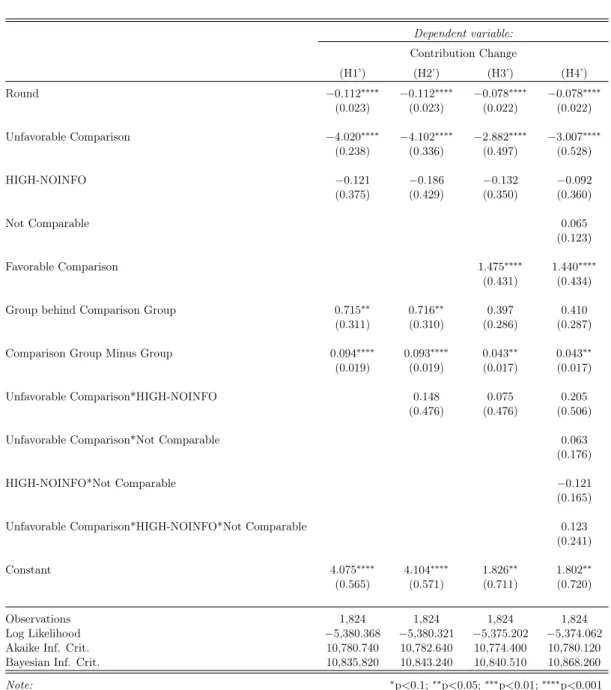The influence of social comparisons on cooperation and fairness
Inauguraldissertation zur Erlangung des Doktorgrades der
Wirtschafts- und Sozialwissenschaftlichen Fakultät der Universität zu Köln
2019 vorgelegt von
MA Jarid Emanuel Zimmermann aus
Nelson, Kanada.
i
Referent: Prof. Dr. Bettina Rockenbach Korreferent: Prof. Dr. Matthias Sutter Tag der Promotion: 09.12.2019
Danke!
Ich danke Nora, Luc und meiner ganzen Familie, sowie allen, die dazu beigetragen haben dies möglich zu machen! Ganz besonderer Dank gilt Bettina Rockenbach und Robert Böhm, die mich bei all meinen Irrungen und Wirrungen stets unterstützt haben und es mir ermöglicht haben meinen Horizont zum Thema Kooperation und Fairness zu erweitern. Großer Dank geht auch an Matthias Sutter, der das Korreferat übernommen hat. David Buttelmann möchte ich für seine Unterstützung beim Kids-Experiment danken. Bei Caroline Stein, Anna Untertrifaller und Sebastian Butschek möchte ich mich für die mentale Unterstützung bei der Arbeit, aber auch für die Ablenkung davon, bedanken. Beim Team Rockenbach (Thomas Lauer, Heike Kirch, den beiden Sebastians, also Schneiders und Tonke, Lukas Wenner) und bei Stefania Bortollotti, Christoph Feldhaus, Felix Kölle, Matthias Praxmarer, Uta Schier und Claudia Zoller möchte ich mich für viele anregende Diskussionenen im Büro, in der Mensa und am Kaffeestand bedanken. Urs Fischbacher danke ich dafür, dass ich über mehrere Monate teil seiner Forschungsgruppe in Konstanz sein durfte. Aus Konstanz danke ich zudem Fabian Dvorak, der den Kontakt hergestellt hat, sowie David Grammling und Jan Hausfeld, die ihr Büro mit mir geteilt haben.
Contents
1 Introduction 1
1.1 Overview and Main Findings . . . 3
1.2 Co-Authors and Acknowledgements . . . 6
2 United we stand, divided we fall: The limitations of between-group comparisons for fostering within-group cooperation 7 2.1 Introduction . . . 7
2.2 Materials and Methods . . . 9
2.2.1 Experimental Design . . . 9
2.2.2 Participants and Procedure . . . 10
2.3 Hypotheses . . . 11
2.4 Results . . . 15
2.5 Discussion . . . 23
2.6 Conclusion . . . 25
2.A Experimental instructions . . . 26
2.B Post-experimental questionnaire . . . 33
2.C Descriptive statistics . . . 35
2.D Statistical model equations . . . 36
2.E Mixed-effect models H0-H4 with MPCR µ= 0.8 . . . 40
2.F Additional analyses . . . 41
2.G Questionnaire data . . . 45
3 The driving forces behind information acquisition in social decisions 47 3.1 Introduction . . . 47
3.2 Experiment . . . 49
3.2.1 Participants and Procedure . . . 49
3.2.2 Experimental Design . . . 50
3.2.3 Treatments . . . 52
3.3 Hypotheses . . . 53
3.3.1 The Model . . . 54
3.4 Results . . . 55
3.5 Discussion and Conclusion . . . 60
3.A The Model . . . 63
3.B Demographic Controls . . . 67
3.C Chosen source of social comparison information . . . 68
3.D Transfers . . . 69
3.E Instructions . . . 71
4 Social-comparison engineering in children 83 4.1 Introduction . . . 83
4.2 Experiment . . . 86
4.2.1 Participants and Procedure . . . 86
4.2.2 Experimental Design . . . 86
4.2.3 Treatments . . . 88
4.3 Hypotheses . . . 89
4.4 Results . . . 93
4.5 Discussion and Conclusion . . . 97
4.A Children’s answers to questions of understanding . . . 99
4.B Reasons for children’s choices . . . 99
4.C Instructions . . . 100
5 The desire to set an example: Do people cooperate more if they have social influence? 105 5.1 Introduction . . . 105
5.2 Previous Literature . . . 107
5.3 Experiment . . . 108
5.3.1 Participants and Procedure . . . 108
5.3.2 Experimental Design . . . 109
5.3.3 Treatments . . . 110
5.3.4 Post-experimental questionnaire . . . 111
CONTENTS v
5.4 Hypotheses . . . 112
5.5 Results . . . 114
5.6 Discussion and Conclusion . . . 121
5.A Regressions analyzing social influence . . . 124
5.B Instructions . . . 126
Bibliography 140
Statutory declaration 159
Curriculum Vitae 161
Chapter 1
Introduction
The ability to foster and maintain cooperation and fairness is a key determinant of (economic) well-being in human societies. When two or more individuals cooperate, they engage in joint actions that, even though costly to the individual, create mutual benefits (Bowles and Gintis, 2008). Similarly, fairness decisions require that an individual gives up a part of his or her own resources and re-distributes it to others (Kahneman et al., 1986). Both cooperation and fairness decisions have been shown to crucially depend on social information, that is, information about other people’s behavior. Field studies have shown that people make higher contributions to public goods (Chen et al., 2010; Frey and Meier, 2004), are more likely to donate to charitable organizations (Shang and Croson, 2009), and refrain from littering (Cialdini et al., 1991), if others do so, too. Yet, some interventions have also produced undesirable effects (Schultz et al., 2007;
Fellner et al., 2013; Bhanot, 2017), and the underlying psychological processes remain unclear.
Hence, in a series of economic experiments, this dissertation sets out to investigate how and why social information impacts cooperation and fairness decisions.
Early advances in behavioral-economic theory have focused on people’s prosocial motivations to explain reactions to social information (Fehr and Schmidt, 1999; Bolton and Ockenfels, 2000;
Charness and Rabin, 2002). For example, they modeled prosocial motivations as the result of payoff-comparisons between direct interaction partners, i.e., ‘social preferences’ for equitable outcomes (Bolton and Ockenfels, 2000; Fehr and Schmidt, 1999). From this perspective, social information affects decisions because it reveals information about others’ resources and people dislike having less (or more) than others. While the early theories have substantial explanatory power, they fail to explain the ‘flickery’ nature of social behavior, e.g., why fair-minded people would actively seek (and follow) information suggesting unfair behavior. Importantly, the early
theories have abstracted from people’s desire for positive signals about themselves, which are key in social-psychological theory (e.g., Leary and Baumeister, 2000) and so-called ‘second-generation models’ of social preferences (Bodner and Prelec, 2003; Bénabou and Tirole, 2006; Andreoni and Bernheim, 2009; Bénabou and Tirole, 2011). This dissertation thus presents four economic experiments focusing particularly on how people’s desires to send positive signals about their own prosociality, i.e, self- and social signaling, help explain the impact of social information on cooperation and fairness decisions.
From a social psychological perspective, people look to social information to answer questions they find relevant for themselves: How should I evaluate my own actions? How will others evaluate my actions? Where do I stand relative to others? In other words, they use social information with the purpose of social comparison, i.e., to evaluate themselves and their decisions relative to their social environment and its social norms (Cialdini et al., 1991; Festinger, 1954;
Taylor et al., 1996; Tesser, 1988).
Self-signaling motives, i.e., the desire to appear prosocial to oneself, might arise because people lack perfect knowledge about their ‘true’ motivations, so they need to rely on ‘hard facts’
such as their own actions to infer ‘who they really are’. Equivalently, one could say that people want to see themselves as prosocially motivated persons or that they care about their self-image (Bem, 1972; Bénabou and Tirole, 2006; Leary and Baumeister, 2000; Mazar et al., 2008). In this view, people might behave more cooperatively due to social information because it makes salient their prosocial identity. Speaking to self-signaling motives, Chapter 2 explores the conditions under which people try to boost their self-image as a prosocial person by cooperating in their own team, if their team’s cooperativeness is compared to that of another team (Tajfel and Turner, 1979; Turner, 1975). Relatedly, Chapter 5 investigates whether or not people’s desire for prosocial identity motivates them to set an example for others.
Social-signalingmotives, i.e., the desire to appear prosocial to others, might arise since people care about how spectators, be they real or imaginary, perceive their motivations (Andreoni and Bernheim, 2009; Ariely et al., 2009; Bénabou and Tirole, 2006). An external spectator cannot know an individual’s preferences, so he or she needs to rely on an individual’s actions to infer his or her ‘true’ motivations. For instance, people may desire to appear prosocial to others in order to (i) receive higher social approval (Leary, 2007) or (ii) to be chosen as partners (Barclay and Willer, 2007). Note that if the desire to send positive signals about oneself enters preferences, inferences about the own motivations are ‘strategic’ (Bénabou and Tirole, 2016; Kunda, 1990):
Individuals might prefer positive over negative signals about their prosocial motivation. In
1.1. OVERVIEW AND MAIN FINDINGS 3 Chapter 3, we therefore test whether people acquire social comparison information strategically, if it might negatively affect not only their self-, but also their social-signaling. Building on Chapter 3, Chapter 4 studies when and how children develop the ability to strategically select social comparison information.
So far, we have implicitly assumed that cooperation and fairness decisions are (perceived as) socially desirable. Yet, what is perceived as socially desirable crucially depends on the prevalent social norms in society (Herrmann et al., 2008), and social information can crucially affect people’s norm perceptions (Krupka and Weber, 2009). Descriptive norms depend on what
‘is typically done’ in a given situation;injunctive norms depend on what ‘should be done’ in a given situation (Cialdini et al., 1991). In conjunction with the own ‘true’ prosocial motivations, social norms will affect how self- and social signaling works by affecting which behaviors are considered as socially desirable and thus how people’s behavior affects their appearance (Mazar et al., 2008). Accordingly, the impact of social information on normative perceptions will play an important, yet tacit, role in each of the following chapters.
1.1 Overview and Main Findings
The following section provides an overview of the economic experiments featured in this dissertation and summarizes their main findings.
Chapter 2, entitled “United we stand, divided we fall: The limitations of between-group comparisons for fostering within-group cooperation”, is published as Böhm et al. (2018). We investigate how between-group comparisons affect within-group cooperation decisions. Previous work has shown that the provision of information about the average contributions of a payoff-independent comparison group can increase within-group contributions in the public goods game. This study extends previous work by studying how (the perception of) between-group asymmetries in the between-group comparison affects within-group contributions. In particular, one group is disadvantaged because it faces a lower marginal-per-capita-return (MPCR) to cooperation than its comparison group. To test how the perception of disadvantages in one group affects within-group cooperation, we vary whether or not group members are aware of the between-group asymmetry.
We find that participants generally desired to be ‘ahead of’ their comparison group, providing evidence for the importance of people’s desire for positive (group) distinctiveness.
Yet, in addition, the perception of between-group asymmetries led members of disadvantaged
groups to respond more sensitively to within-group comparisons, i.e., to how their own payoffs compared to those of their group members. More precisely, participants more strongly reduced their contributions when their team members were free-riding. Particularly those participants who more strongly perceived that contributions are not comparable between groups reduced their contributions more strongly. Our findings can be explained from a self-signaling perspective: When the information made salient their group’s disadvantages, members of disadvantaged groups focused more strongly on within-group comparisons (e.g., payoff-comparisons with their team members) to maintain a positive self-image.
Chapter 3 is entitled “The driving forces behind information acquisition in social decisions”.
This chapter is joint work with Robert Böhm and Bettina Rockenbach. We let people choose which social comparison information they want to acquire (or avoid) before making a fairness decision – a transfer from their own endowment to an anonymous recipient in the dictator game.
Previous work has shown that people avoid information about the adverse consequences of their own actions, if the information is available only to themselves. Contrary to previous work, in our experiment, we varied whether or not the acquired social information could become public or not, so the social information could not only affect what people think of themselves (self-signaling), but also what other people think of them (social-signaling).
We find that if the acquired information became public and thus more strongly influenced people’s prosocial appearance, people were more likely to acquire social information suggesting low prosocial behavior, and they used it as an excuse for making a low transfer. We also provide clean evidence that those who acquired information suggesting low prosocial behavior were also less prosocially motivated per se. In particular, they transferred less than others, irrespective of the social information they received. This experiment thus shows how prosocial motivation and social signaling interact in information acquisition. From a policy perspective, our results suggest that making social information public may produce unintended results, if those with a low prosocial motivation use the information in a strategic way.
Chapter 4, “Social-Comparison Engineering in Children” is joint work with David Buttelmann, Robert Böhm und Bettina Rockenbach. Here we build on the finding from Chapter 3 that adults choose social comparison information strategically: We ask when and how the ability to choose social comparisons strategically, that is, even against the own preferences, develops in children. In a field study, children made drawings and, subsequently, they could choose between low-accuracy and high-accuracy drawings to serve as their comparison standard. In one treatment, children won a prize if their drawing was more
1.1. OVERVIEW AND MAIN FINDINGS 5 accurate than the comparison standard. Hence, children could win and enhance their appearance by choosing a low-accuracy drawing – making their own drawing appear more accurate. In another treatment, children won if their drawing was less accurate than the comparison standard. We also elicited children’s basic preference in a treatment, where there was no evaluation at all.
Notably, children exhibited a strong basic preference for high-accuracy compared to low- accuracy drawings when there was no evaluation. As a result, children needed to overcome an inner conflict in the treatment where choosing the low-accuracy drawing made them win. In this situation, only children from 6-7 years of age, but not younger children, managed to strategically choose the comparison standard that made them win. By contrast, children of all ages managed to win similarly often if choosing the high-accuracy drawing made them win. Children’s developing abilities to inhibit conflicting impulses, but not their desire to win, or their desire to be liked by others, could explain the age differences in strategically choosing social comparisons. This suggests that children’s ability to inhibit conflicting impulses is not only important for individual decisions, such as resisting temptations, but also for success in social situations more generally.
In Chapter 5, entitled “The desire to set an example: Do people cooperate more if they are influential?”, I investigate when and how people desire to set an example for others. Compared to previous studies, this study aims to isolate people’s psychological motives to set an example for others by focusing on situations where there are no monetary incentives to set an example.
Participants (‘first-team players’) decided on a contribution to their team’s public good, and, subsequently, their contributions provided information for ‘follower-teams’ that independently played their own respective public goods games. To vary whether or not first-team players had social influence via the contribution information they provided, I varied whether first-team players’ decisions were revealed to follower-teams before or after follower-teams made their decisions. To vary the salience of social norms, participants either had the opportunity to write a recommendation about what follower-teams should contribute or did not have such an opportunity.
I find that only when first-team players had social influence and could write a recommendation, first-team players reported a higher motivation to set an example and also made higher contributions compared to first-team players who did not have social influence and could (or could not) write a recommendation. Hence, only when the opportunity to write a recommendation made salient injunctive norms, people’s self-image as a prosocial person became sufficiently salient so that people desired to set an example. As a side-finding, I further
document follower-team player’s intriguing inclination to follow high (normative) but not low (counter-normative) contributions.
1.2 Co-Authors and Acknowledgements
This dissertation was financed by the grant “The influence of social comparisons on cooperation and fairness” from the German Research Foundation [grant number 246329797] which was awarded to Bettina Rockenbach as a part of the research group “Relativity in Social Cognition”
(speakers Thomas Mussweiler and Christian Unkelbach).
Chapter 2 was co-authored by Robert Böhm and Bettina Rockenbach and is published as Böhm et al. (2018). The authors gratefully acknowledge funding from the German Research Foundation [grant number 246329797]. We are greatly indebted to fruitful comments from and discussion with Thomas Mussweiler, Wilhelm Hofmann, Christian Unkelbach, and other seminar participants of the research unit on “Relativity in Social Cognition”.
Chapter 3 was co-authored by Robert Böhm and Bettina Rockenbach and is based on Böhm et al. (2019). The authors gratefully acknowledge funding from the German Research Foundation [grant number 246329797]. We are greatly indebted to fruitful comments from and discussion with Thomas Mussweiler, Wilhelm Hofmann, Christian Unkelbach, and other seminar participants of the research unit on “Relativity in Social Cognition”. We also thank seminar participants at the conference of the 2018 ESA European Meeting and the theem conference (2017).
Chapter 4 was co-authored by Robert Böhm, David Buttelmann and Bettina Rockenbach and is based on Zimmermann et al. (2019). The authors gratefully acknowledge funding from the German Research Foundation [grant number 246329797]. We are greatly indebted to fruitful comments from and discussion with Wilhelm Hofmann, Christian Unkelbach, and other seminar participants of the research unit on “Relativity in Social Cognition” as well as participants of the Cologne Social Cognition Meeting 2018, the GSDS Conference in Konstanz, and the 2019 ESA Asia-Pacific Meeting.
Chapter 5 is based on Zimmermann (2019). The author gratefully acknowledges funding from the German Research Foundation [grant number 246329797] and from the Junior Start-Up Grant “Does the prospect of being influential increase cooperation?” of the Center for Social and Economic Behavior at the University of Cologne. I am greatly indebted to comments on earlier drafts of this paper from Caroline Stein, Robert Böhm, and Thomas Lauer.
Chapter 2
United we stand, divided we fall
The limitations of between-group comparisons for fostering within-group cooperation
2.1 Introduction
Competition between work teams is a common means to increase team performance. Experiments with natural groups (e.g. Goette et al., 2006, 2012) and groups formed in the laboratory (e.g.
Abbink et al., 2012) demonstrate how competition between teams can help to overcome the downward trend in cooperation that is typically observed in public goods games. Yet, not only competition but also the mere provision of comparison information about an independent other group can foster within-group cooperation (Böhm et al., 2013; Burton-Chellew and West, 2012; Cárdenas and Mantilla, 2015; Sausgruber, 2009; Tan and Bolle, 2007). The cooperation- enhancing effect of between-group comparisons can be attributed to increased salience of group identity, resulting from a desire for positive distinctiveness and self-view (Mazar et al., 2008;
Tajfel and Turner, 1979).1
Previous research has focused on (the benefits of) comparisons between symmetric groups.
However, natural groups differ vastly on various domains. In many cases, individuals in different groups face different returns from cooperation. For instance, teams differ in terms of task complexity and team heterogeneity (Jehn et al., 1999). Additionally, an equivalent amount of cooperation effort may yield greater returns in a team working on tasks with a high stake than in a team working on routine tasks. Often, group members will know about the different returns from cooperation in other groups in their environment and, nevertheless, compare their
1Even in a setting with symmetric between-group comparisons, contributions to the public good may deteriorate if a comparison group provides a bad example, for instance by contributing very little.
own group’s performance to that of other groups. Importantly, most social comparisons occur automatically, also to others who are not directly comparable (Gilbert et al., 1995; Verduyn et al., 2015). Apart from comparisons that occur automatically, a manager might consider making comparison information salient in order to increase team performance in teams with different returns from cooperation.
In this paper, we thus ask how information about different returns from cooperation in different groups affects individual decision processes when between-group comparison information is available. We thereby provide the first empirical test of how individuals’
perception of differences in between-group comparisons affects within-group cooperation behavior. Psychological research on the perception of social groups (Ames, 2004; Corcoran and Mussweiler, 2009) suggests that social comparisons between structurally different groups might backfire by tainting the own group’s perception, e.g., by increasing the salience of the own group’s negative characteristics vis-à-vis the comparison group.
We aim at delineating the conditions under which – intended or unintended – comparisons between structurally different groups could have detrimental effects on within-group performance.
To this end, we experimentally investigate a public goods game with comparison information about another group with a different return from cooperation, i.e., a different marginal per capita return. To answer the question of how the perception of differences between groups affects within-group cooperation, we vary whether or not groups have information about the structural difference between their own group and their comparison group. We suspect that only when group members have been made aware of the differences between groups, might this lead them to perceive between-group comparisons to be inadequate, and, in turn, might affect within-group cooperation.
Our findings support the view that, when individuals have information about the differences between groups, within-group cooperation becomes more fragile. We still observe that the desire to avoid ‘lagging behind’ the comparison group motivates contributions. Yet, we also find important limitations to between-group comparisons: Having information about structural between-group differences leads members of disadvantaged groups (i.e., groups with lower returns from cooperation) to reduce their contributions more strongly in response to unfavorable within-group comparisons. An analysis of inter-individual heterogeneity reveals that in particular those individuals who agree that the comparison group is not comparable to the own group decrease their contributions more strongly in response to unfavorable within-group comparisons.
2.2. MATERIALS AND METHODS 9 In the following, we first describe our experimental design and derive our hypotheses regarding comparison processes among structurally different groups. Finally, we present our results in more detail, which are discussed afterwards.
2.2 Materials and Methods
2.2.1 Experimental Design
We study the effect of between-group comparisons when groups are structurally different in a public goods game. Two groups, g and h, with four players each, both play a repeated linear public goods game for 20 rounds (using a partner matching protocol). The groups play independently, i.e., one group cannot directly influence the other group’s payoff. We assign either blue or green identities to groups.2 In each roundt, all players of both groups receive an identical endowment ofe= 20. Each playeriof groupgdecides on a contributionci,g,t ∈[0, e]to her group account. Aggregate group contributions per round P
cj,g,t are redistributed equally to every group member and multiplied by the marginal per capita return (MPCR)µg. µg<1constitutes free-riding incentives of group members. Playeri’s payoff in roundtisπi,g,t=e−ci,g,t+µgP
cj,g,t. The same rules apply to players of grouph. Players of groupgreceive information on the average contributions of their comparison grouph,¯ch,t−1, and their own groupg,¯cg,t−1, in the preceding roundt−1, and vice versa.
To implement structural differences, one group faces a high MPCR (µg = 0.8), while the other group has a low MPCR (µh = 0.4). Empirically, a higher MPCR facilitates higher cooperation levels although free-riding incentives remain unchanged (Isaac and Walker, 1988). As additional controls, we have two further treatments where both groups have the same MPCR (µg =µh = 0.4).
To isolate how the perception of differences between groups affects within-group cooperation behavior, we additionally vary whether players only know the MPCR of their own group (NOINFO) or the MPCRs of both groups (INFO). In INFO treatments, the instructions explicitly informed players about the MPCR of the own group and the MPCR of the comparison group. By contrast, instructions in NOINFO treatments only contained information about the MPCR of the own group but did not contain any information about the MPCR of the comparison group. These variations comprise six experimental treatments,
2We rely on minimal, artificial groups to exclude group-specific stereotypes and a history of conflict (Tajfel et al., 1971). However, meta-analytical evidence suggests that the average effect size of ingroup favoritism does not differ in interactions between members from natural vs. artificial groups (Balliet et al., 2014).
summarized in Table 2.1.
Structural difference between groups Is the MPCR of comparison group known?
yes no
Own group MPCRµg = 0.4
Comparison group MPCR µh = 0.8
LOW-INFO LOW-NOINFO
Own group: MPCRµ g = 0.8
Comparison group: MPCRµh = 0.4
HIGH-INFO HIGH-NOINFO
Both groups: MPCRµ g =µ h = 0.4 SAME-INFO SAME-NOINFO Table 2.1: Experimental treatments.
2.2.2 Participants and Procedure
We recruited N = 384 students via ORSEE (Greiner, 2015), resulting in 96 groups with four players each. The experiment was conducted in zTree (Fischbacher, 2007). Participants took part in experimental sessions of 32 players each, with each session being randomly assigned to one of the experimental conditions. There were two separate rooms, and players in different rooms were connected via the software. Participants of the same group were seated in the same room; participants of the respective comparison groups were seated in the other room. Because there were four groups in each room, participants could infer neither the identity of the other players in their own group nor the identity of players in their matched comparison group.
Participants received written instructions for the public goods game (see Appendix 2.A).
Additionally, instructions were read aloud to ensure common knowledge. Participants had to answer questions of understanding before they actually started playing. In the INFO treatments, participants’ questions also related to the comparison group’s MPCR (same MPCRs in SAME- INFO and different MPCRs in LOW-INFO/HIGH-INFO, respectively). In NOINFO, questions related only to the MPCR of the own group.
After the 20 game-playing rounds, participants completed a questionnaire assessing their perceptions regarding the interaction situation on 7-point-scales (for details, see Appendix 2.B).
We asked participants about their motivations for contributing to their group account. Further, we elicited the degree to which participants identify with their own group by using three items (Cronbach’s α = 0.82, Doosje et al. (1995), e.g., “I identify as a member of my group.”). To assess whether participants consider the comparison group to be sufficiently similar for comparing
2.3. HYPOTHESES 11 contributions between groups, we elicited their agreement with the statement: “The contributions of the other group are not comparable to the contributions in my group.” We also assessed whether participants experience joy (or anger) when their group lies ahead (or lags behind) the comparison group.
After completing the post-experimental questionnaire, participants received their final payoff information and were paid in private. Participants earned on average about 18 Euro in sessions that lasted about 60 - 90 minutes.
2.3 Hypotheses
Social psychological research suggests that comparisons between structurally different groups may enhance the desire for positive distinctiveness of the own group, i.e., the status of the own group vis-à-vis the comparison group (Tajfel and Turner, 1979; Turner, 1975). When groups are symmetric and between-group information is available, research on public goods games has confirmed that individuals desire not to ‘lag behind’ a comparison group (Böhm et al., 2013;
Burton-Chellew and West, 2012; Cárdenas and Mantilla, 2015; Sausgruber, 2009; Tan and Bolle, 2007). This desire, in turn, increases individuals’ willingness to contribute to the provision of their group’s public good. The desire to obtain positive distinctiveness is thus a potent motivational force and we expect it to operate regardless of whether individuals have or do not have information about their structural disadvantages, i.e., their lower return from cooperation relative to the comparison group. More precisely, individuals in both LOW-INFO and LOW- NOINFO should increase their contributions when their own group has contributed less than the comparison group, in an attempt to restore positive distinctiveness. Conversely, the desire for positive distinctiveness may be reduced when the group has contributed more than the comparison group, so in this case individuals should decrease their contributions. In the following, we focus on groups who lag behind their comparison group, because, from a group identity perspective, lying ‘ahead’ might also boost positive distinctiveness, whereas ‘lagging behind’ is an unambiguous threat to positive distinctiveness.
Hypothesis 1 (LOW): Individuals in structurally disadvantaged groups increase their contributions when lagging behind the comparison group in terms of contributions.
For individuals in structurally advantaged groups, i.e., individuals in HIGH-INFO and HIGH- NOINFO, the comparison group may be a less relevant comparison standard. This is because the own group typically lies ahead of the comparison group, so individuals may already feel distinct
in a positive way. Nonetheless, we expect individuals to be motivated by their desire not to lag behind the comparison group (albeit to a lesser extent).
Hypothesis 1 (HIGH): Individuals in structurally advantaged groups increase their contributions when lagging behind the comparison group in terms of contributions.
When a comparison group is perceived as different from the own group, this may not only affect between-group comparisons but may also taint the individuals’ perception of their own group. According to the theory of ‘optimal distinctiveness’ (Brewer, 1991; Brewer and Weber, 1994), people’s need for positive distinctiveness crucially determines how they attend to social information. Hence, when comparison groups are perceived as sufficiently structurally similar, between-group comparison processes should become important. In this case, individuals may expect to obtain positive distinctiveness by boosting their group identity. By contrast, when the own group is perceived as structurally disadvantaged, comparison processes between individuals of the same group should become more important. In LOW-INFO, individuals most likely expect their own group to perform worse in terms of contributions. As they dislike lagging behind the comparison group, they may focus more strongly on themselves compared to others within their group in order to achieve positive distinctiveness, i.e., they focus on personal identity rather than on group identity. It follows that within-group comparisons should become more salient.3,4
In within-group comparisons, conditional cooperation has been shown to play a crucial role (Fischbacher et al., 2001; Kelley and Stahelski, 1970). Conditional cooperation is often selfishly biased, meaning that unfavorable within-group comparisons receive more weight than favorable within-group comparisons (Fischbacher and Gächter, 2010). Thus, we expect individuals who have information about their group’s structural disadvantage to respond more harshly particularly to unfavorable within-group comparisons.
Hypothesis 2 (LOW): If individuals have information about the structural disadvantage of their group, they reduce their contribution more strongly in response to unfavorable within-group comparisons than if they do not have information about their disadvantage.
3This does not mean that between-group comparisons should become less self-relevant. By contrast, a pre- condition for a stronger focus on personal identity is that people who receive information about disadvantages in their group find the group comparison to be self-relevant and dislike lagging behind their comparison group.
4An alternative explanation for the increased salience of within-group comparisons may relate to the selective accessibility model of social comparisons (Mussweiler, 2003). This model predicts that after an initial assessment of similarity, individuals engage in a selective search, confirming either similarities or differences: Individuals who initially expect chances of cooperation to be lower in the own group may attend more strongly to unfavorable within-group comparisons (to confirm their initial expectation of low cooperation). Note that while within-group comparisons should become more salient, between-group comparisons should not, because information about a group’s disadvantage also makes it easier to explain why the own group lags behind the comparison group.
2.3. HYPOTHESES 13 For structurally advantaged groups, information about the structural advantage reflects positively on their group’s distinctiveness. Consequently, contrary to disadvantaged groups, we do not expect individuals to focus on personal identity when receiving information about their advantages.5 Yet, the structural advantage also makes it more difficult to attribute relative successes to the own group’s positive distinctiveness alone rather than to external circumstances. Hence, we expect having information about the own group’s structural advantage to neither positively nor negatively affect reactions to within-group comparisons.
Hypothesis 2 (HIGH): If individuals have information about the structural advantage of their group, they do not reduce their contribution more strongly in response to unfavorable within- group comparisons than if they do not have information about their advantage.
In our design, the key manipulation is to provide (or not to provide) information about the dimension of similarity, and we expect perceptions of similarity to be affected regardless of whether individuals have information about structural advantages or structural disadvantages.
A wide array of psychological research shows that perceived similarity is one of the most important moderators of social comparisons (Ames, 2004; Corcoran et al., 2011). At the same time, there is also considerable evidence suggesting that people use social information in a self-serving way, especially when the information is highly self-relevant (Kunda, 1990;
Pyszczynski et al., 1985; Taylor et al., 1996). Hence, particularly if individuals have information about their structural disadvantage – which may potentially threaten positive distinctiveness – they may use the information in a self-serving way to argue that groups are not sufficiently similar for contributions to be comparable between groups. Members of disadvantaged groups may thus feel that contributions are not comparable (and perhaps ought not to be compared) between groups, and thus they focus more strongly on how they compare to others in their team, i.e., their personal identity.6,7 We thus hypothesize that the individual’s (ex-post) perception that contributions are not comparable between groups should play a key role with regard to how strongly individuals reduce their contributions in response
5This is also in accordance with models of inequity aversion, where disadvantageous inequities are strictly more aversive than advantageous inequities (Fehr and Schmidt, 1999).
6This is not to say that individuals who perceive that groups are not comparable also attend less to between- group comparison information or that their desire to keep up with the comparison group is hampered (this would contradict Hypothesis 1). Instead, the argument here is that individuals use information about differences between groups to maintain a positive self-view when focusing on their personal identity.
7Alternatively, individuals who perceive that contributions are not comparable between groups may simply focus on within-group comparisons as a result of their selective search for differences rather than for similarities.
In this case, we need to assume that the desire for positive group distinctiveness operates regardless of perceived similarity, so between-group comparisons are not affected by an individual’s perception that contributions are not comparable between groups.
to unfavorable within-group comparisons:
Hypothesis 3 (LOW): If they have information about the structural advantage of their group, individuals who agree more strongly that contributions are not comparable between groups should reduce their contributions more strongly in response to unfavorable within-group comparisons.
This relation should be stronger in groups that have information about their disadvantage than in groups that do not have information about their disadvantage.
Self-serving information processing should be present in disadvantaged but not in advantaged groups because only information about structural disadvantages threatens the own chances of achieving positive (group) distinctiveness. For a structurally advantaged group, between-group comparisons are less self-relevant and less threatening because such a group is continuously ahead of its comparison group. For this reason, we do not expect an individual’s perception that contributions are not comparable between groups to predict that an individual will focus on personal identity.
Hypothesis 3 (HIGH): If they have information about the structural advantage of their own group, individuals who agree more strongly that contributions are not comparable between groups should not reduce their contributions more strongly in response to unfavorable within-group comparisons. This relation should be similar in groups that do not have information about their advantage.
See Table 2.2 for an overview of our hypotheses.
Hypotheses
H1 (LOW) In disadvantaged groups: Contributions increase when the own group lags behind the comparison group.
H1 (HIGH) In advantaged groups: Contributions increase when the own group lags behind the comparison group.
H2 (LOW) Contribution reductions in response to unfavorable within-group comparisons:
LOW-INFO > LOW-NOINFO
H2 (HIGH) Contribution reductions in response to unfavorable within-group comparisons:
HIGH-INFO≈HIGH-NOINFO
H3 (LOW) Contribution reductions in response to unfavorable within-group comparisons are stronger for individuals who agree more strongly that contributions are not comparable between groups: LOW-INFO>LOW-NOINFO
H3 (HIGH) Contribution reductions in response to unfavorable within-group comparisons are not stronger for individuals who agree more strongly that contributions are not comparable between groups: HIGH-INFO≈HIGH-NOINFO
Table 2.2: Overview of Hypotheses.
2.4. RESULTS 15
2.4 Results
On the aggregate level, groups with a low return from cooperation (MPCRµ= 0.4, LOW-INFO and LOW-NOINFO) show a similar downward trend in cooperation over rounds, whereas groups with a higher return from cooperation (MPCRµ= 0.8, HIGH-INFO and HIGH-NOINFO) show only a modest downward trend in contributions, so contributions stay at a much higher level (see also Figure 2.1 and Appendix 2.C for descriptive statistics). This observation is in line with previous research showing that a higher MPCR leads to higher contributions, even though free-riding incentives remain unchanged (Isaac and Walker, 1988).
Figure 2.1: Group-aggregated contribution levels across rounds.
To see how information about between-group differences in returns from cooperation affects the individual underlying decision processes, we first look at group-aggregates to foreshadow our main results. Namely, individuals who have information about their group’s structural disadvantage have the tendency to reduce their contributions more strongly when members of the own group contribute less than the individual (unfavorable within-group comparisons) compared to individuals who do not have information about their group’s disadvantage (MWU:
LOW-INFO vs. LOW-NOINFO, mean -3.74 vs. -2.83, Z = 1.85, p = .068; cf. Result 2 (LOW)). If we further restrict analyses to individuals who agree at median-levels or above within their respective treatment that contributions are not comparable between groups, individuals who have information about their group’s disadvantage show significantly stronger responses to unfavorable comparisons compared to individuals who do not have information about their
group’s disadvantage (MWU: LOW-INFO vs. LOW-NOINFO, mean -5.22 vs. -3.34, Z = 2.62, p = .008, cf. Result 3 (LOW)).8 This is first evidence that having information about structural disadvantages makes individuals less tolerant of unfavorable within-group comparisons, i.e., of within-group free-riding. Further, similarity perceptions seem to play a key role in explaining stronger responses to within-group free-riding.
To investigate formally whether having information about structural differences in between-group comparisons, i.e., information about having different MPCRs, affects individual contribution adaptations in repeated within-group cooperation behavior, we estimate several mixed-effect models. Our models include random effects to account for dependencies between paired groups and within groups (due to feedback information after each round), and at the individual level (due to repeated decisions over rounds). We refer the reader to Appendix 2.D for the equations of our statistical models. As a dependent variable, we analyze the players’
contribution change from the actual to the previous round (Contribution Change). We analyze behavior for players with MPCR µ= 0.4 and MPCRµ= 0.8 separately. Thus, players who are statistically compared face equal incentives across treatments. In Table 2.3, we analyze behavior in groups with MPCR µ = 0.4 by presenting Models L0-L5 (the prefix “L” indicates MPCR µ = 0.4). In Table 2.5 in the Appendix, we additionally analyze behavior in groups with MPCR µ = 0.8 by presenting Models H0-H4 (the prefix “H” indicates MPCR µ = 0.8) analogously to Models L0-L4.
Our models account for behavioral patterns known from the literature by estimating different fixed effects. As a measure of conditional cooperation (e.g., Fischbacher et al., 2001), we use a dummy variable indicating whether average contributions by group members were lower than an individual’s contribution in the preceding round (Unfavorable Comparison).9 To measure the impact of between-group comparisons (e.g., Böhm et al., 2013), we use a dummy variable indicating whether contributions in the preceding round in the own group were lower than in the comparison group (Group Behind Comparison Group).10 Moreover, our models include
8Re-estimating this test for individuals who agree at below median-levels in their respective treatment that contributions are not comparable between groups yields no significant differences to individuals in disadvantaged groups who do not have information about their disadvantages (MWU: LOW-INFO vs. LOW-NOINFO, mean -3.26 vs. -2.99,Z = 0.68,p= .529).
9Please note that individuals who contribute zero to the public good can avoid receiving an unfavorable within-group comparison. This raises a selection issue which might affect our coefficient estimates forUnfavorable Comparison. If we exclude individuals who contribute zero from our analysis, however, our coefficient estimates for Unfavorable Comparison are barely affected.
10We do not include a variableGroup Ahead Comparison Group, since this variable is almost perfectly collinear with Group Behind Comparison Group (Spearman’sρ= -.94). There are only 3 out of 240 periods in LOW-INFO groups and 3 out of 240 in LOW-NOINFO groups where average contributions are the same as for the group with higher MPCR (SAME-INFO: 16/240, SAME-NOINFO: 5/240).
2.4. RESULTS 17 treatment dummies to address unexplained heterogeneity between treatments (withLOW-INFO as the reference category in Models L0-L5; withHIGH-INFOas the reference category in Models H0-H4). We also include Round as a time trend indicator.
In Models L0 and H0, we include only treatment dummies and the variable Group Behind Comparison Groupto estimate the ‘full’ effect of between-group comparisons on contributions. In contrast, Models L1 and H1 also control for conditional cooperation and a time trend. Consistent with studies investigating between-group comparisons in public goods games, we find evidence for the motivating force of positive group distinctiveness, especially in structurally disadvantaged groups (Hypothesis 1 (LOW)).
Result 1 (LOW): If the own group is structurally disadvantaged, individuals increase their contributions when lagging behind the comparison group (βGroup Behind Comparison Group, Model L0, p < .001, Models L1-L2, p-values < .10, Models L3-L4, p-values < .05, Model L5, p <
.001).
Result 1 (HIGH): If the own group is structurally advantaged, individuals do not systematically increase their contributions when lagging behind the comparison group (βGroup Behind Comparison Group, Model H0,p < .10, Models H1-H4, p-values > .10).11
In Models L2 and L3, we analyze how the information about the structural disadvantage, i.e., about having a lower MPCR, changes players’ reactions to within-group behavior. We extend Model L1 by adding interactions between Unfavorable Comparison and treatment dummies. As before, we use LOW-INFO as a reference group, so the coefficient βUnfavorable Comparison (without treatment interactions) shows how individuals in LOW-INFO change their contributions in response to unfavorable within-group comparisons. The treatment interactions, e.g., βUnfavorable Comparison*LOW-NOINFO, further reveal how responses to unfavorable within-group comparisons in LOW-INFO differ compared to other treatments, e.g., LOW-NOINFO. Positively signed interaction coefficients indicate that reductions in response to unfavorable within-group comparisons are stronger in LOW-INFO compared to the other treatments. In Model L3, we additionally include a variable indicating whether other group members contributed more on average than the individual in the preceding round (Favorable Comparison). We include this variable because it can be interpreted as measuring positive
11We find partial support for Hypothesis 1 (HIGH), when we extend our models by the variable Comparison Group Minus Group measuring the continuous difference between the comparison groups’ and the own group’s average contribution (see Table 2.7 and 2.8 in the Appendix, Models L1’-L4’ and H1’-H4’). In particular, we observe that for individuals in advantaged groups, contributions increase as between-group differences increase (βComparison Group Minus Group, Models H1’- H4’, allp-values < .05).
reciprocity, i.e., responses from reciprocating free-riders, while Unfavorable Comparison can be interpreted as measuring negative reciprocity, i.e., responses to others’ free-riding behavior.12 We conduct analagous analyses for structurally advantaged players in Models H2 and H3.
Consistent with our central hypothesis (Hypothesis 2 LOW), individuals’ sensitivity to unfavorable within-group comparisons increases if they have information about their own group’s disadvantage, but not if they have information about their own group’s advantage (Hypothesis 2 HIGH):
Result 2 (LOW):Individuals who have information about their group’s structural disadvantage (LOW-INFO) reduce their contributions considerably more strongly in response to unfavorable within-group comparisons (by 39%, Model L3) than individuals who do not have information about their disadvantage (LOW-NOINFO) (βUnfavorable Comparison*LOW-NOINFO, Models L2-L3, p-values < .01).
Result 2 (HIGH): Individuals who have information about their group’s structural advantage (HIGH-INFO) do not reduce their contributions significantly more strongly than individuals who do not have information about their advantage (HIGH-NOINFO) (βUnfavorable Comparison*LOW-NOINFO, Models H2-H4,p-values > .10).
This suggests that particularly if individuals have information about their structural disadvantage, they become less tolerant of within-group free-riding, so that within-group cooperation becomes more fragile. Figure 2.2 plots the cumulative distribution of individuals’
average contribution reductions in response to unfavorable within-group comparisons separately for the treatments LOW-INFO and LOW-NOINFO. The figure supports Result 2 (LOW) by showing that harsh reactions to unfavorable within-group comparisons are more frequent in LOW-INFO than in LOW-NOINFO. Importantly, contribution reductions in response to unfavorable within-group comparisons are also stronger in LOW-INFO than in treatments without structural differences, regardless of whether individuals have information (LOW-INFO vs. SAME-INFO: βUnfavorable Comparison*SAME-INFO, Models L2-L3, p-values < .05, reduction difference 25% in Model L3) or do not have information about facing the same MPCR (LOW-INFO vs. SAME-NOINFO: βUnfavorable Comparison*SAME-NOINFO, Models L2-L3, p-values < .01, reduction difference 33% in Model L3).
12Individuals contributed the same as the group average in 15% of the cases in LOW-INFO (LOW-NOINFO:
11%, SAME-INFO: 19%, SAME-NOINFO: 17%; HIGH-INFO: 9%; HIGH-NOINFO: 15%), so collinearity between Favorable Comparison and Unfavorable Comparison is unproblematic (Spearman’sρ= -.72). Favorable Comparison significantly increases model fit, so we retain it in Models L4-L5. Dropping it does not change significance patterns in ways affecting our results.
2.4. RESULTS 19
Contribution Change
(L0) (L1) (L2) (L3) (L4) (L5)
LOW-NOINFO 0.004 0.120 −0.320 −0.377 −0.493 −1.038
(0.225) (0.218) (0.274) (0.262) (0.318) (0.700)
SAME-INFO 0.210 0.032 −0.305 −0.242 −0.322 −0.811
(0.197) (0.192) (0.237) (0.227) (0.283) (0.633)
SAME-NOINFO 0.221 0.124 −0.290 −0.238 −0.298 −0.982
(0.198) (0.191) (0.238) (0.228) (0.284) (0.632) Group behind Comparison Group 0.736**** 0.217∗ 0.223∗ 0.265∗∗ 0.278∗∗ 0.565∗∗∗∗
(0.136) (0.129) (0.130) (0.127) (0.127) (0.162)
Round −0.038∗∗∗∗ −0.038∗∗∗∗ −0.023∗∗ −0.024∗∗ −0.030∗∗∗
(0.011) (0.011) (0.011) (0.011) (0.011) Unfavorable Comparison −4.103∗∗∗∗ −4.970∗∗∗∗ −4.224∗∗∗∗ −3.908∗∗∗∗ −4.263∗∗∗∗
(0.125) (0.302) (0.331) (0.385) (0.914)
Unfavorable Comparison*LOW-NOINFO 1.154∗∗∗ 1.195∗∗∗ 1.004∗∗ 0.872
(0.424) (0.422) (0.484) (1.045)
Unfavorable Comparison*SAME-INFO 0.903∗∗ 0.855∗∗ 0.620 0.443
(0.370) (0.368) (0.419) (0.934)
Unfavorable Comparison*SAME-NOINFO 1.101∗∗∗ 1.052∗∗∗ 0.719∗ 0.995
(0.369) (0.367) (0.418) (0.935)
Favorable Comparison 0.906∗∗∗∗ 0.893∗∗∗∗ 0.892∗∗∗∗
(0.176) (0.176) (0.182)
Not Comparable −0.037 0.015
(0.108) (0.127)
Not Comparable*LOW-NOINFO −0.049 −0.082
(0.135) (0.162)
Not Comparable*SAME-INFO −0.047 −0.139
(0.125) (0.145)
Not Comparable*SAME-NOINFO 0.020 −0.029
(0.127) (0.150)
Unfavorable Comparison*Not Comparable −0.412∗∗∗ −0.743∗∗∗∗
(0.157) (0.199)
Unfavorable Comparison*Not Comparable* 0.570∗∗∗ 0.780∗∗∗
LOW-NOINFO (0.210) (0.266)
Unfavorable Comparison*Not Comparable* 0.693∗∗∗∗ 1.111∗∗∗∗
SAME-INFO (0.189) (0.230)
Unfavorable Comparison*Not Comparable* 0.398∗∗ 0.728∗∗∗
SAME-NOINFO (0.190) (0.238)
Interactions with other questionnaire variables are omitted for brevity in this table.
Constant -1.031∗∗∗∗ 1.307∗∗∗∗ 1.629∗∗∗∗ 0.727∗∗ 0.792∗∗ 1.452∗∗
(0.187) (0.228) (0.251) (0.301) (0.344) (0.663)
Observations 5,472 5,472 5,472 5,472 5,472 5,472
Log Likelihood −16,356 −15,870 −15,865 −15,852 −15,840 −15,902
Model Fit Increase (L-Ratio:X2) - 970.7∗∗∗∗ 10.4∗∗ 26.1∗∗∗ 24.4∗∗∗ 176.6∗∗∗∗
∗p <0.1;∗∗p <0.05;∗∗∗p <0.01;∗∗∗∗p <0.001
Table 2.3: Mixed-effects models predicting contribution change. Clustering is at the level of a pair-of-groups, the group, and the individual. LOW-INFO is the reference category. In Models L1- L5, the model fit does not significantly increase by adding interactions between treatment dummies and Favorable Comparison (e.g., L-Ratio test against Model L3,X2(3)= 0.26, p= 0.964) or Group Behind Comparison Group (e.g., L-Ratio test against Model L3,X2(3)= 1.22, p = 0.748). See Appendix Table 2.6, for the corresponding Models L3a and L3b.
Figure 2.2: Cumulative distribution of individual contribution change in response to unfavorable within- group comparisons.
In Models L4 and L5, we investigate whether information about structural disadvantages has a stronger effect on participants who agree that contributions are not comparable between groups (Not Comparable). We extend Model L3 by interacting Not Comparable with Unfavorable Comparison and treatment dummies. As before, we use LOW-INFO as a reference group, so the coefficient βUnfavorable Comparison*Not Comparable reveals – for the treatment LOW-INFO – the relation between responses to unfavorable within-group comparisons and an individual’s agreement that contributions are not comparable between groups. The treatment interactions, e.g., βUnfavorable Comparison*Not Comparable*LOW-NOINFO, further reveal how this relation differs from LOW-INFO in other treatments. We repeat analogous analyses in Model H4 for advantaged groups. We find support for Hypothesis 3 (LOW):
Result 3 (LOW): Individuals who agree more strongly that contributions are not comparable between groups also reduce their contributions more strongly (in LOW-INFO, βUnfavorable Comparison*Not Comparable, Models L4-L5, p-values < .001) and they reduce their contributions more strongly if they have information about their structural disadvantage than if they do not have this information (LOW-NOINFO, βUnfavorable Comparison*Not Comparable*
LOW-NOINFO, Models L4-L5,p < .01).
2.4. RESULTS 21 Contrary to disadvantaged groups, we find that the perception that contributions are not comparable between groups does not predict reductions in response to unfavorable within-group comparisons in advantaged groups, which supports Hypothesis 3 (HIGH):
Result 3 (HIGH): Individuals in structurally advantaged groups who agree more strongly that contributions are not comparable between groups do not reduce their contributions more strongly in response to unfavorable within-group comparisons, regardless of whether they have information or do not have information about their structural advantage (e.g., βUnfavorable Comparison*Not Comparable, Model H4, p > .50).
Figure 2.3 corroborates Result 3 (LOW) by showing that individuals with above-median (modal) agreement (Not Comparable: Median = 7) display much harsher reactions to unfavorable within-group comparisons than those below the median. Moreover, agreeing that contributions are not comparable between groups also affects contribution reductions more strongly in LOW-INFO than in treatments without structural differences, regardless of whether individuals have information (SAME-INFO, βUnfavorable Comparison*Not Comparable*SAME-INFO, Model L4-L5, p < .05) or do not have information about facing the same MPCR (SAME-NOINFO, βUnfavorable Comparison*Not Comparable*SAME-NOINFO, Model L4-L5, p < .001).
Figure 2.4 in the Appendix shows the distribution of the variable Not Comparable for groups with a lower MPCR (LOW-INFO, LOW-NOINFO, SAME-INFO, SAME-NOINFO) and groups with a higher MPCR (HIGH-INFO and HIGH-NOINFO). Interestingly, in LOW-INFO the mode of the variableNot Comparable is 7, whereas in LOW-NOINFO the mode of the variable Not Comparable is 1. For HIGH-INFO and HIGH-NOINFO groups, there is a similar but less pronounced shift in distributions. This suggests that the provision of information about structural differences greatly changes players’ perceptions that contributions are not comparable between groups. For an overview of descriptive questionnaire data for each treatment, we refer the reader to Appendix 2.G.
In Model L5, we account for the multiple measures in our questionnaire, which makes it more likely for differences to be detected by chance (multiple comparisons). We interact each of the questionnaire measures with Unfavorable Comparison and treatment dummies. For each questionnaire measure, we can thus infer how responses to unfavorable within-group comparisons depend on the questionnaire measure and how this relation differs from LOW-INFO in other treatments. To obtain adjusted p-values for the 42 possible comparisons (14 questionnaire measures x 3 control treatments), we apply a step-down Dunnett procedure.
Figure 2.3: Cumulative distribution of individuals’ contribution change in response to unfavorable within-group comparisons conditional on whether individuals agree that contributions of groups are not comparable between groups (Not Comparable).
The finding from Result 3 (LOW) (i.e., that an individual’s agreement that contributions are not comparable between groups explains why this individual reacts more harshly to unfavorable comparisons in LOW-INFO but not in LOW-NOINFO) is robust to this very conservative procedure at a 10% level (LOW-NOINFO, βUnfavorableComparison*Not Comparable*LOW-NOINFO, adjusted p = .092, SAME-NOINFO, βUnfavorableComparison*Not Comparable*SAME-INFO, adjusted p
= .062, SAME-INFO, βUnfavorableComparison*Not Comparable*SAME-NOINFO, adjustedp < .001).
While there are no robust interaction effects for other questionnaire measures, their assessment still yields interesting insights. By and large, emotional reactions and perceptions in the decision situation affect contribution adaptations in expected directions: Individuals experiencing anger (joy) over their group’s poor (good) relative performance decrease (increase) their contributions more strongly (βAnger = -0.300, βJoy = 0.318, both p-values < .05).
Moreover, individuals who perceive the decision situation as a between-group comparison show harsher contributions reductions in response to unfavorable within-group comparisons (βUnfavorable Comparison*Between-Group Comparison = -0.306, p < .10). Perhaps most interestingly, individuals in LOW-INFO who report more joy when their group lies ahead reduce their contribution more strongly in response to unfavorable within-group comparisons (Model L5,
2.5. DISCUSSION 23 LOW-INFO as reference group, βUnfavorable Comparison*Joy = -0.466, p < .10) in comparison to individuals reporting more joy in LOW-NOINFO, SAME-INFO and SAME-NOINFO (βUnfavorable Comparison*Joy*LOW-NOINFO = 0.627, βUnfavorable Comparison*Joy*LOW-NOINFO = 0.720, βUnfavorable Comparison*Joy*LOW-NOINFO = 0.582, all p-values < .10). This suggests that individuals in LOW-INFO, who find the between-group comparison to be more self-relevant, react more harshly to free-riding, potentially in order to motivate group members to ‘stand together’.
2.5 Discussion
We investigate a pervasive and practically relevant condition of economic peer effects:
comparisons between structurally different groups. Although we confirm the general pattern that the desire to avoid ‘lagging behind’ a comparison group motivates within-group cooperation in the public goods game, we report important limitations of between-group comparisons for fostering within-group cooperation. That is, if group members have information about the own group’s structural disadvantage, they are more sensitive to how well their group ‘stands together’. Compared to individuals who do not have information about their group’s disadvantage, they reduce their contributions more strongly in response to unfavorable within-group comparisons.
Our data provide some hints on the underlying mechanism. In particular, the extent to which individuals agree that contributions are not comparable between groups predicts why some individuals react more harshly than others when faced with unfavorable within-group comparisons in disadvantaged groups. Notably, this finding is in line with the idea that individuals often use social comparison information in a self-serving way (Kunda, 1990;
Pyszczynski et al., 1985; Taylor et al., 1996): For individuals in disadvantaged groups, the between-group comparison is highly self-relevant, because it potentially threatens the own group’s positive distinctiveness, which is not the case for advantaged groups. In line with this, perceptions that contributions are not comparable between groups predict contribution reductions in response to unfavorable within-group comparisons for individuals who have information about their groups’s disadvantages, but not for individuals who have information about their group’s advantages. We also find some suggestive evidence that greater joy (when the own group lies ahead) predicts harsher contribution reductions in response to unfavorable comparisons, but again only for individuals who have information about their group’s
